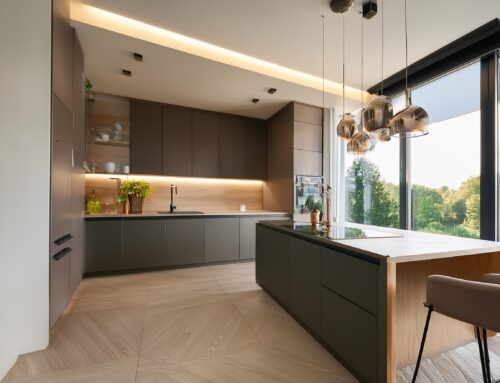When remodeling your kitchen in Connecticut, one temptation might be to save money by refinishing your existing cabinets instead of replacing them. After all, cabinets tend to be the largest single expense in a kitchen remodel, so why not cut out that cost if you can? You might be surprised: refinishing cabinets can often cost nearly as much as replacing them entirely, without the added benefits that new cabinets provide. Today we’re going to take a deeper look at why we always recommend cabinet replacement over refinishing.
The High Cost of Refinishing Cabinets
When remodeling your kitchen in Connecticut, one temptation might be to save money by refinishing your existing cabinets instead of replacing them. However, refinishing cabinets can often cost nearly as much as replacing them entirely.
Labor Costs Add Up Quickly
Professional refinishers charge by the hour, and refinishing kitchen cabinets can be a lengthy, labor-intensive process. Cabinets must be thoroughly cleaned, stripped of old finishes, sanded, repaired, primed, painted, and sealed. With an average cost of $50-100 per hour, labor alone can cost $1000 or more for a medium-sized kitchen.
Materials Can Be Expensive
Quality primers, paints, stains and sealers designed for cabinet refinishing can run you $300-500 in materials. Factor in extra costs for any repairs, new hinges, handles and other hardware needed to update the look. Suddenly that “cheap” refinish starts looking a lot more expensive.
Refinishing Doesn’t Last Long
Even professionally refinished cabinets show signs of wear relatively quickly. The finishes simply don’t hold up well compared to factory finishes on new cabinetry.
Sealers Wear Off Over Time
Kitchens are high-use areas exposed to moisture, oils and frequent handling. The sealer on refinished cabinets wears away after 1-2 years, allowing stains and scratches to show through. Refinishing then requires sanding and resealing every couple of years to keep cabinets looking decent.
Moisture Penetrates Refinished Surfaces
Kitchen cabinets see a lot of moisture from cooking steam, dripping and spills. This moisture penetration causes the new paint or stain to blister, crack and peel much faster than a factory finish.
Refinishing Damages Cabinets
In order to apply new finishes, existing cabinet surfaces must be aggressively prepped and stripped. This process often damages cabinets, especially delicate veneers and woods.
Sanding Can Ruin Veneers
Most kitchen cabinets have veneered wood surfaces. Sanding too aggressively can sand right through the thin veneer layer, ruining the look of cabinets. New veneers are extremely difficult and expensive to replace.
Chemicals Corrode Finishes and Woods
Chemical paint and varnish strippers used in refinishing can soak into wood surfaces, corroding the underlying wood and finishes. This leads to uneven, damaged surfaces once new finishes are applied.
Replacing is More Cost Effective
Due to the costs and drawbacks of refinishing, replacement cabinets are often the more economical option for upgrading your Connecticut kitchen.
New Cabinets Often Cheaper Than Refinishing
With all costs considered, replacing worn cabinets with new mid-range options costs only marginally more than a quality refinishing job. For a few hundred dollars more, you get brand new cabinets built to last 20-30 years or more.
Better Return on Investment with New Cabinets
Since refinished cabinets show wear much quicker, replacement cabinets retain their value longer. This leads to higher resale value for your Connecticut home. Realtors agree – new cabinets provide a bigger bang for your buck.
New Cabinets Have More Benefits
Beyond cost savings, replacement cabinets give you advantages over refinishing in terms of quality, customization and convenience.
More Storage and Organization Options
New cabinets offer features like roll-out shelves, lazy susans and other upgrades your old cabinets likely lack. Better storage and accessibility make your kitchen more user-friendly.
Can Update Look of Whole Kitchen
Replacing cabinets allows you to reconfigure your kitchen layout for better workflow. New cabinet styles, colors and hardware let you give your whole kitchen an updated, modern look.
Easier to Clean and Maintain
Factory finishes on new cabinets resist moisture, grease and grime much better than refinished cabinets. They clean up easier and stay looking new longer with just basic care.







